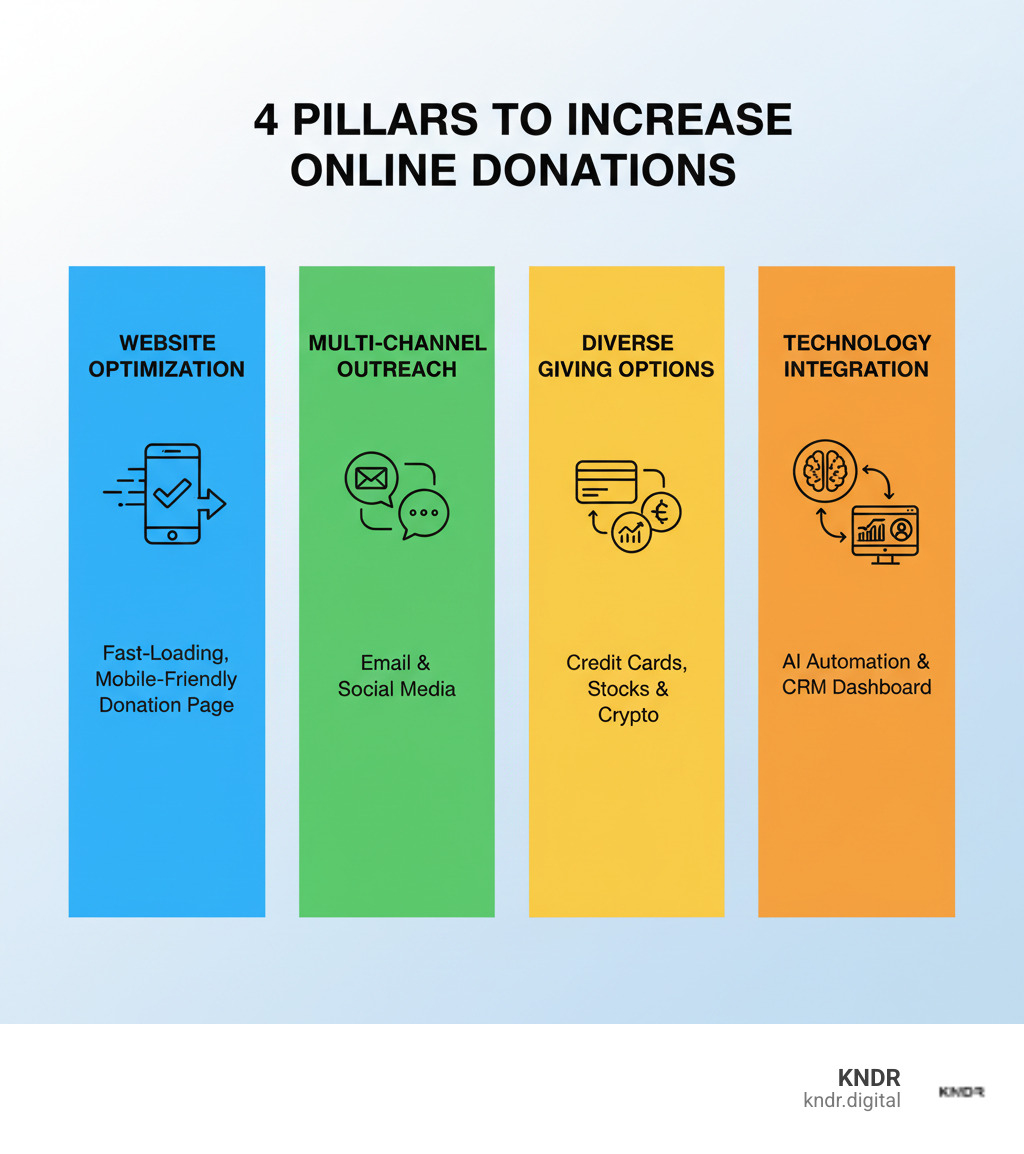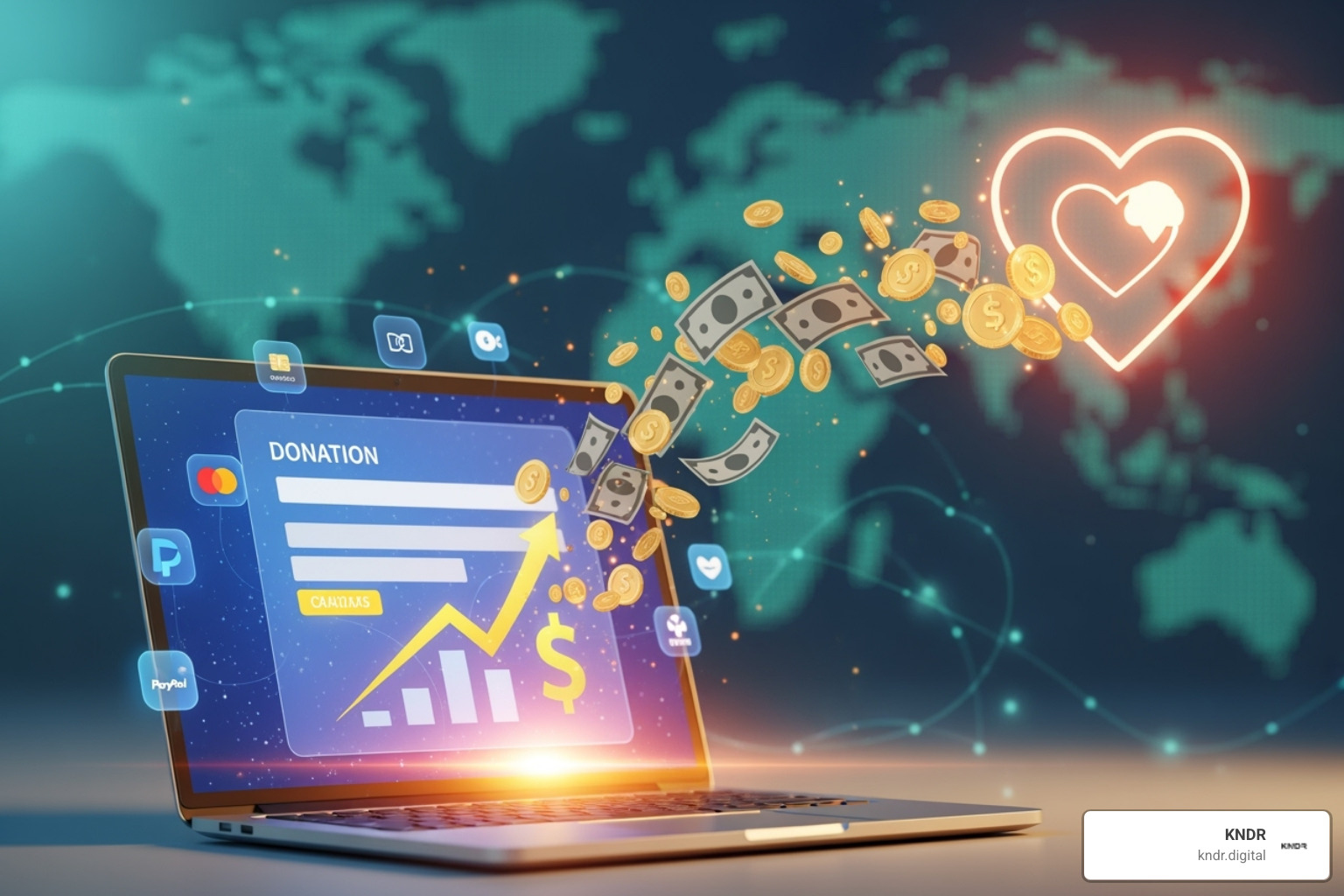Don't Just Ask, Get: Proven Strategies to Increase Online Giving

Why Digital Fundraising Can't Wait: The Online Giving Opportunity
Increase online donations and you open up a revenue channel that's growing faster than any other. Here's what you need to know:
Quick Strategies to Increase Online Donations:
- Optimize your donation page - Simplify forms, add mobile wallets, and ensure it loads in under 3 seconds.
- Leverage email marketing - Segment your lists and send targeted appeals.
- Enable recurring giving - Monthly donations account for a significant portion of online revenue.
- Use AI and personalization - Tailor donation asks and predict donor behavior.
- Offer multiple payment options - Include digital wallets, stocks, crypto, and DAFs.
- Make mobile a priority - A large percentage of donations now happen on mobile devices.
- Promote social proof - Display charity rating badges to build trust.
The numbers don't lie. Online giving now represents nearly one-third of all nonprofit donations, yet only 1.5% of website visitors complete a donation. That's a massive gap between potential and reality.
The barriers are real. Over 80% of visitors to donation pages leave without giving due to long forms, slow load times, and trust issues. Many nonprofits simply don't ask clearly or often enough.
But here's the opportunity: nonprofits that optimize their digital fundraising see dramatic results. Simple, strategic changes—like adding a value proposition to a donation page or improving a donate button—can lead to double-digit increases in giving. It's about creating a seamless digital ecosystem where donors can give easily and feel confident about their impact.
This shift to digital-first fundraising isn't just about convenience; it's about survival. With donor retention rates dropping, consistent digital communication is key to growth. The organizations that master digital engagement will thrive.
I'm Mahir Iskender, and at KNDR, we help nonprofits increase online donations through AI-powered marketing and digital fundraising systems. We've seen how reducing friction, building trust, and personalizing the donor experience can transform stagnant giving into sustainable growth.

Key terms for increase online donations:
Optimize Your Digital Foundation: Website and Donation Pages
Your website is your digital front door, and your donation page is where intention becomes action. To increase online donations, this foundation must be flawless, inviting, and trustworthy.
Crafting High-Conversion Donation Pages
A great donation page does more than collect payments; it tells a story and builds confidence.
Consistent branding is crucial. Your donation page should look and feel like a natural part of your website. Matching colors, fonts, and messaging reassures donors they're in the right place, reducing hesitation.
Your call-to-action (CTA) buttons need to be compelling. Instead of a generic "Donate," try emotional and specific language like "Feed a Family Tonight." This clarity tells donors exactly what their gift will accomplish. Organizations that focus on Landing Page Optimization for Non-Profit Organization Success see much better results.
Explaining the real-world impact of a donation—your value proposition—can dramatically boost giving. When donors understand what their money achieves, they are far more likely to give.
Trust signals are your secret weapon. Displaying charity rating badges can increase the likelihood of a donation by 72% because it answers the donor's question: "Is this organization legitimate?" Security badges from payment processors and a visible .org domain also build confidence, as 68% of donors trust .org addresses more.
Finally, highlight employer matching programs. A stunning 84% of donors are more likely to give if they know their gift can be matched, effectively providing free money for your cause.
How to reduce donation form abandonment and increase online donations
Over 80% of people who visit donation pages leave without giving, often due to frustratingly long forms. The solution is radical simplicity. Ask only for the essentials: name, email, and payment information. Every extra field is another reason for a donor to abandon the process.
Mobile wallet integration is a game-changer. Options like Apple Pay, Google Pay, and PayPal allow donors to give in seconds with just a few taps, which is especially powerful on mobile devices.
If you must use a multi-step form, show a progress bar. A simple "Step 2 of 3" indicator reduces anxiety and keeps donors moving forward. The fastest donation experiences are often four times quicker than traditional forms. This is a core principle of Online Fundraising Optimization—removing every barrier between intention and action.
Mastering Mobile Optimization and Website Speed
With 45% of online donations now happening on mobile devices and over 60% of website traffic coming from phones, mobile optimization is no longer optional. Your donation page must look and function perfectly on any screen, with large, tappable buttons and readable text.

But design isn't enough; speed is critical. If your page takes more than 3 seconds to load, visitors will leave. Bounce rates soar by 90% when load time increases from 1 to 5 seconds. Every second of delay costs you donations.
Fortunately, speed is fixable. Compressing images, enabling browser caching, and choosing fast hosting are technical improvements that directly translate to more completed donations. Why faster sites convert better is a proven reality. Following Digital Fundraising Best Practices means making your mobile experience effortless.
Boost Your Outreach: Email and Social Media Strategies
Once your digital foundation is solid, it's time to engage donors where they already are: in their inboxes and on social media. Email marketing delivers a powerful return, while social media builds community and inspires action. Combined with a strong recurring giving program, these channels create a sustainable fundraising ecosystem.

Email is your direct line to interested supporters, while social media casts a wider net to build awareness. Together, they guide people from curiosity to commitment.
Leveraging Social Media for Donor Engagement and Action
Social media is a powerful fundraising tool, with 25% of donors saying it inspired them to give. Your supporters are already scrolling; you just need to give them compelling stories and real-time updates that create an emotional connection.
However, the lifespan of a social media post is short, so consistency is key. You must also tailor your content to each platform's unique format and audience. What works on Instagram may not work on LinkedIn.
Facebook and Instagram offer built-in fundraising tools that make giving seamless. While they account for a small percentage of total online revenue, a significant number of donors have used them and say they would again. These platforms are especially effective for peer-to-peer campaigns where social proof drives action.
Successful nonprofits integrate social media with email and website content, use paid ads for targeted outreach, and actively engage with their community. For more strategies, explore our guides on Social Media for Nonprofits and Charity Digital Marketing.
The Power of Email Segmentation for Targeted Fundraising Appeals
Despite the buzz around social media, email remains the champion of donor communication. A significant 48% of donors prefer email for updates and appeals, and 33% say it's the tool that most inspires them to give.
However, sending generic emails to your entire list is a missed opportunity. A new donor needs a different message than a longtime major supporter. Segmentation is the key to exceptional results. By grouping your audience based on behavior and demographics, you can tailor your messaging and speak directly to their relationship with your organization. This approach can increase click rates by 15% and is a major reason email delivers 4x the ROI of social media.
Consider segmenting your lists for new donors, lapsed donors, major donors, and volunteers. Each group has different motivations and needs. Personalization, such as using a donor's name and referencing their past support, makes them feel seen and valued. This connection is powerful; donor retention increases by 29% for offline donors when you have their email address.
Our Nonprofit Email Marketing: Complete Guide and insights on AI-Driven Email Campaigns can help you master this vital channel to increase online donations.
Promoting Recurring Giving for Sustainable Long-Term Support
One-time gifts are great, but recurring giving is what allows your organization to thrive. Monthly giving accounts for 31% of all online revenue, providing the predictable financial stability needed for long-term planning.
To encourage monthly commitments, make recurring options highly visible on your donation page. Consider making it the default choice. Strategic pop-up prompts can also be effective, nudging one-time donors to become monthly supporters after they've completed a gift.
Most importantly, explain the impact of consistent support. Show donors how their monthly gift of $24 adds up to $288 a year, funding continuous, reliable programs. Make the process easy by accepting preferred payment methods like credit cards and ACH.
Once someone becomes a monthly donor, treat them like a VIP with regular updates on their collective impact. An Automated Donation System can manage these transactions smoothly, freeing your team to focus on building relationships.
Expand Your Reach and Revenue Streams
To truly increase online donations, we must accept new ways of giving. This means empowering your community to fundraise on your behalf, accepting non-cash assets, and understanding that different donors are motivated by different things.
Implementing Peer-to-Peer Fundraising Campaigns to Boost Donations
Your most passionate supporters want to do more than just donate. Peer-to-peer (P2P) fundraising turns them into active fundraisers for your cause. They create their own fundraising pages and share personal stories with their networks, leveraging the power of trust and personal connection.
The results are impressive. The average P2P fundraiser raises hundreds of dollars, and an estimated 14% of P2P donors go on to participate in future campaigns. P2P is not just a fundraising tactic; it's a powerful donor acquisition strategy.
P2P is particularly effective with younger, digitally-native generations who are motivated by causes their peers support. By giving your supporters easy-to-use tools and compelling content, you can build a movement around your mission. Our guide on Peer-to-Peer Fundraising Nonprofit can help you get started.
Why Offering Multiple Donation Options is Crucial for Growth
Most wealth isn't held in cash. According to philanthropy expert Dr. Russell James, 89% of wealth is in non-cash assets like stocks, real estate, and cryptocurrency. If you only accept credit card donations, you're missing out on your donors' largest giving potential.

Accepting stocks, crypto, and contributions from Donor-Advised Funds (DAFs) can open up larger, more tax-efficient gifts. Beyond that, offering a variety of payment methods like digital wallets (Apple Pay, PayPal) and ACH bank transfers makes giving faster and more convenient.
By diversifying your giving options, you attract new donors, enable larger gifts, and show that you understand modern donor preferences. This is a key strategy to increase online donations and build a more sustainable revenue stream.
Understanding How Demographics Influence Online Giving
Not all donors are the same. Understanding generational and demographic differences is central to Data-Driven Fundraising.
Generational patterns are striking. The Silent Generation and Baby Boomers are the most generous in total dollars, valuing loyalty and direct impact stories. Generation X leads in volunteer hours, suggesting that appeals linking donations to tangible action are effective. Millennials are highly responsive to social media and peer-to-peer campaigns.
Gender also plays a role, with women making up the majority of donors, especially on days like GivingTuesday. Affluent households give significantly more than the average donor, making major donor cultivation a critical activity.
There's also a powerful link between volunteering and donating: 73% of volunteers also give financially to the nonprofits they support. Volunteer recruitment is therefore also a donor development strategy.
By understanding these nuances, you can tailor your appeals, channels, and messaging to resonate with each group's unique motivations, making your fundraising more personal, authentic, and effective.
Leverage Technology to Increase Online Donations
Technology is the backbone of modern fundraising. The right tools don't just improve efficiency—they fundamentally change how we connect with donors and increase online donations.
How to use AI and intelligent tools to improve the donor experience
Artificial Intelligence is no longer a future concept; it's an accessible tool that is changing nonprofit engagement. Think of AI as a tireless assistant, learning from data to help you create more meaningful donor experiences.
The magic of AI is its ability to personalize the giving journey at scale. For instance, intelligent tools can analyze a website visitor's data in real-time to suggest donation amounts custom to their profile. This removes guesswork and significantly increases the likelihood and size of a gift.
AI also powers predictive analytics, which can identify which supporters are most likely to become major donors. By analyzing giving patterns and engagement history, these tools help your development team focus their efforts on building the most promising relationships.
Donor journey automation is another key benefit. AI-driven systems can send timely, personalized communications—such as thank-you emails, re-engagement messages to lapsed donors, or even birthday greetings. These automated touchpoints feel personal and genuine, strengthening donor relationships without manual effort.
Given that donor retention rates have fallen, AI's ability to predict churn and prescribe the right messaging to win back supporters is invaluable. This allows you to focus on strategy and relationship-building while AI handles repetitive tasks. For a deeper dive, explore our guides on AI-Driven Fundraising and Best AI Tools for Nonprofits.

Choosing Your Fundraising Platform: Build vs. Buy
Every nonprofit faces the choice: build a custom fundraising solution or buy an existing platform? While a custom build offers perfect tailoring, it comes with high upfront costs, ongoing maintenance, and a long development timeline.
Dedicated online fundraising platforms offer a compelling alternative. For a subscription and transaction fees, you get a comprehensive, ready-to-use system built by fundraising experts. The time to launch is dramatically faster—days or weeks, not months or years.
Security is another crucial factor. Dedicated platforms provide built-in PCI compliance, fraud protection, and security teams, handling complex regulations so you don't have to. They also offer a full suite of features, from Charity CRM Solutions and branded donation pages to peer-to-peer tools and text-to-give capabilities.
For most nonprofits, investing in a dedicated solution provides the most reliable and efficient path to increase online donations. Be sure to use Donation Tracking Software to measure your success.
| Feature | Dedicated Platform (Buy) | Custom Solution (Build) |
|---|---|---|
| Cost | Platform fees (monthly/annual) + transaction fees | High upfront development costs, ongoing maintenance, and updates |
| Features | Ready-made, comprehensive features (donation forms, CRM, P2P, events, text-to-give) | Custom precisely to your needs, but requires significant development time and expertise |
| Maintenance | Vendor handles updates, security, and bug fixes | Requires internal IT team or external developers for all maintenance |
| Scalability | Often built to scale with growing needs, handles high traffic (e.g., GivingTuesday) | Scalability must be planned and developed, potentially costly to upgrade |
| Time to Launch | Quick setup, often within days or weeks | Months or even years of development |
| Security | Built-in PCI compliance, fraud protection, dedicated security teams | Requires significant internal expertise and resources to ensure compliance and security |
Building Trust and Credibility in the Digital Age
Trust is everything in fundraising. In the digital world, building it requires intentional effort.
Transparency is at the heart of donor trust. 75% of donors look for information about a nonprofit's achievements before giving. Regularly share success stories and impact reports using a strong Nonprofit Storytelling Framework: From Concept to Conversion to show that their dollars make a real difference.
Security is non-negotiable. Displaying security badges and using well-known, PCI-DSS compliant payment processors signals that donor information is safe. A professional, well-designed website with a .org domain—which 68% of donors trust most—also conveys credibility.
A strong, consistent brand identity across all digital channels reinforces that you are a stable, trustworthy organization. Finally, be explicit about privacy with a clear policy on how donor data is used. As we accept automation, responsible AI use that prioritizes donor trust is paramount.
This foundation of trust creates an environment where donors feel confident giving again and again, allowing you to sustainably increase online donations.
Frequently Asked Questions about Increasing Online Donations
What is the best time of year to run an online fundraising campaign?
While year-round engagement is crucial, certain periods are golden for fundraising. December is the fundraising Super Bowl, accounting for 25% of all annual online revenue. The final three days of the year are particularly critical, bringing in 10% of the entire year's online total as donors rush to make tax-deductible gifts.
GivingTuesday, the Tuesday after Thanksgiving, is another unmissable event, raising billions for causes worldwide. Plan major campaigns around these high-impact moments, but weave them into a year-round strategy that maintains donor relationships during quieter months.
Should I ask donors to cover the credit card processing fees?
Yes, but you should make it optional. The data shows that while 55% of online donors will opt-in to cover processing fees, for others, the request can create friction and even deter a gift. The best approach is to include it as a simple, unchecked (or easily unchecked) box on your donation form.
The golden rule is to never let fees become a barrier. Your primary goal is to make giving as smooth as possible. If a donor chooses to cover the fee, it's a bonus for your mission. If not, you've still secured a valuable donation and supporter.
What is a good donation page conversion rate for a nonprofit?
The industry average conversion rate for a donation page is a surprisingly low 1.5%. This means that for every 100 people who visit a nonprofit's website, only one or two complete a donation. This shows there is massive room for improvement.
However, rates vary widely based on mission, traffic quality, and page optimization. Some organizations achieve rates as high as 49% with highly optimized systems. Therefore, a "good" conversion rate is one that is better than it was last month. Focus on continuous improvement. A small increase from 1.5% to 2% represents a 33% jump in donations, which can translate to thousands of additional dollars for your mission over time.
Conclusion
The journey to increase online donations is about meeting your donors where they are—in the digital world—with a smart, seamless, and trustworthy strategy.
We've walked through the essentials: optimizing your website for speed and mobile use, segmenting your email outreach for personalization, diversifying your giving options to include non-cash assets, and leveraging powerful technology like AI to automate and improve the donor experience. You've found that offering stocks, crypto, and digital wallets isn't just trendy; it's essential when 89% of wealth sits in non-cash assets.
The numbers tell a compelling story: organizations that accept these digital-first strategies see real, measurable results. But beyond the metrics, you're building genuine connections with people who care about your mission. When you remove friction and make giving meaningful, donors respond. They give more, they give again, and they become champions for your cause.
Technology doesn't replace the human touch; it amplifies it. It's a bridge to deeper, more sustained engagement at scale. The nonprofits that thrive are those that use technology to build better relationships.
At KNDR, we've built our entire approach around this philosophy. We combine AI-driven systems with proven fundraising strategies because we believe in results that matter. Our promise is simple: 800+ donations in 45 days or you don't pay. We streamline your fundraising because we know that when nonprofits succeed, communities flourish.
The shift to digital-first fundraising is here. Your donors are ready. Your mission deserves it. The tools to make it happen are within reach.
Ready to transform your fundraising and truly increase online donations? Let's make it happen together. Take your digital fundraising to the next level and see what's possible when strategy meets technology.


